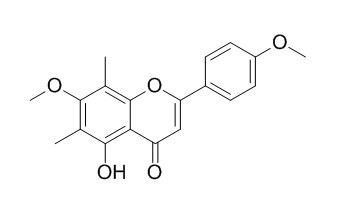Eucalyptin
Eucalyptin has antioxidant and antimicrobial properties, it exhibits potent antimicrobial activities against seven micro-organisms with minimum inhibitory concentrations (MIC) ranging from 1.0 to 31 mg/L. Eucalyptin A exhibits potent inhibition on HGF/c-Met axis.
Inquire / Order:
manager@chemfaces.com
Technical Inquiries:
service@chemfaces.com
Tel:
+86-27-84237783
Fax:
+86-27-84254680
Address:
1 Building, No. 83, CheCheng Rd., Wuhan Economic and Technological Development Zone, Wuhan, Hubei 430056, PRC
Providing storage is as stated on the product vial and the vial is kept tightly sealed, the product can be stored for up to
24 months(2-8C).
Wherever possible, you should prepare and use solutions on the same day. However, if you need to make up stock solutions in advance, we recommend that you store the solution as aliquots in tightly sealed vials at -20C. Generally, these will be useable for up to two weeks. Before use, and prior to opening the vial we recommend that you allow your product to equilibrate to room temperature for at least 1 hour.
Need more advice on solubility, usage and handling? Please email to: service@chemfaces.com
The packaging of the product may have turned upside down during transportation, resulting in the natural compounds adhering to the neck or cap of the vial. take the vial out of its packaging and gently shake to let the compounds fall to the bottom of the vial. for liquid products, centrifuge at 200-500 RPM to gather the liquid at the bottom of the vial. try to avoid loss or contamination during handling.
Food Res Int.2020, 133:109130.
Phys Chem Chem Phys.2018, 20(23):15986-15994
Food Bioscience2023, 53:102687
Sci. Rep.2015, 14-23
J Hepatocell Carcinoma.2022, 9:327-341.
Heliyon.2023, e12684.
Int J Mol Sci.2024, 25(19):10660.
Pharmaceuticals (Basel).2024, 17(4):462.
Research Square2021, 10.21203.
Polytechnic University of Catalonia2017, 105826
Related and Featured Products
Journal of Chemical Sciences,2013,125(4): 765-775.
Antileishmanial polyphenols from Corymbia maculata.[Reference:
WebLink]
METHODS AND RESULTS:
Twelve polyphenols including 8-demethyl Eucalyptin (1), Eucalyptin (2), myrciaphenone A (3), myrciaphenone B (4), quercetin-3-O-β-d-xylopyranoside (5), myricetin-3-O-α-l-rhamnopyranoside (6), quercetin-3-O-β-d-galactopyranoside (7), quercetin-3-O-β-d-glucopyranoside (8), quercetin-3-O-α-l-rhamnopyranoside (9), syringic acid (10), gallic acid-3-methyl ether (11), gallic acid-4-methyl ether (12) and gallic acid (13) were isolated from the active extracts.
CONCLUSIONS:
All the tested compounds except 8-demethylEucalyptin and myrciaphenone B showed strong to moderate (6.9–24.5 \(\upmu\)M) antileishmanial activity against Leishmania donovani promastigotes.
Rapid Commun.Mass Spectrom.,2009 Aug; 23(15):2241-6.
Temperature-dependent release of volatile organic compounds of eucalypts by direct analysis in real time (DART) mass spectrometry.[Pubmed:
19551840]
A method is described for the rapid identification of biogenic, volatile organic compounds (VOCs) emitted by plants, including the analysis of the temperature dependence of those emissions.
METHODS AND RESULTS:
Direct analysis in real time (DART) enabled ionization of VOCs from stem and leaf of several eucalyptus species including E. cinerea, E. citriodora, E. nicholii and E. sideroxylon. Plant tissues were placed directly in the gap between the DART ionization source skimmer and the capillary inlet of the time-of-flight (TOF) mass spectrometer. Temperature-dependent emission of VOCs was achieved by adjusting the temperature of the helium gas into the DART ionization source at 50, 100, 200 and 300 degrees C, which enabled direct evaporation of compounds, up to the onset of pyrolysis of plant fibres (i.e. cellulose and lignin). Accurate mass measurements facilitated by TOF mass spectrometry provided elemental compositions for the VOCs. A wide range of compounds was detected from simple organic compounds (i.e. methanol and acetone) to a series of monoterpenes (i.e. pinene, camphene, cymene, eucalyptol) common to many plant species, as well as several less abundant sesquiterpenes and flavonoids (i.e. naringenin, spathulenol, Eucalyptin) with antioxidant and antimicrobial properties.
CONCLUSIONS:
The leaf and stem tissues for all four eucalypt species showed similar compounds. The relative abundances of methanol and ethanol were greater in stem wood than in leaf tissue suggesting that DART could be used to investigate the tissue-specific transport and emissions of VOCs.
J. Med. Chem.,2012 Sep 27;55(18):8183-7.
Potent HGF/c-Met axis inhibitors from Eucalyptus globulus: the coupling of phloroglucinol and sesquiterpenoid is essential for the activity.[Pubmed:
22934600 ]
METHODS AND RESULTS:
Eucalyptin A (1), together with two known compounds 2 and 3 exhibiting potent inhibition on HGF/c-Met axis, was discovered from the fruits of Eucalyptus globulus. 1 possessed an unprecedented carbon framework of phloroglucinol-coupled sesquiterpenoid, and its structure was elucidated by spectroscopic method and ECD calculation.
CONCLUSIONS:
A brief structure-activity relationship discussion indicated that the coupling of a phloroglucinol and a sesquiterpenoid is essential for the activity.
Lett Appl Microbiol. 2004;39(1):60-4.
Antimicrobial activities of eucalyptus leaf extracts and flavonoids from Eucalyptus maculata.[Pubmed:
15189289 ]
METHODS AND RESULTS:
We investigated the antimicrobial activities of eucalyptus leaf extracts to find effective antibacterial agents.The antimicrobial activities of leaf extracts from 26 species of eucalyptus were measured. Extracts of Eucalyptus globulus, E. maculata and E. viminalis significantly inhibited the growth of six Gram-positive bacteria (Staphylococcus aureus, MRSA, Bacillus cereus, Enterococcus faecalis, Alicyclobacillus acidoterrestris, Propionibacterium acnes), and of a fungus (Trichophyton mentagrophytes), but they did not show strong antibacterial activity against Gram-negative bacteria (Escherichia coli, Pseudomonas putida).
CONCLUSIONS:
2',6'-dihydroxy-3'-methyl-4'-methoxy-dihydrochalcone, Eucalyptin and 8-desmethyl-Eucalyptin, isolated from E. maculata extracts, exhibited potent antimicrobial activities against seven micro-organisms with minimum inhibitory concentrations (MIC) ranging from 1.0 to 31 mg l(-1).
Pharmaceutical Chemistry Journal,2014,48(5): 323-327.
Chemical Studies of Eucalyptus Tincture.[Reference:
WebLink]
METHODS AND RESULTS:
The chemical composition of eucalyptus tincture was studied by extracting and identifying terpenoids – α-terpineol, β-eudesmol, cryptomeridiol, and C-methylflavones – Eucalyptin and 6,8-dimethyl-5,7-dihydroxy-4′-methoxyflavone. Methods for assay of C-methylflavones and flavonoids were developed on the basis of spectrophotometric estimation of colored complexes obtained by treatment with aluminum chloride in acidic conditions. The standard for assay of C-methylflavones was a Eucalyptin solution with λmax of 388 nm; the standard for flavonoids was a quercetin solution with λmax of 417 ± 5 nm. The C-methylflavone content was 0.0058% and the mean flavonoid content was 0.04%.
CONCLUSIONS:
These methods can be used as an alternative for standardization of eucalyptus tincture.
Chemistry of Natural Compounds,1984,20(3):284-287.
Spectral characteristics of C-methylflavones.[Reference:
WebLink]
METHODS AND RESULTS:
A study has been made of natural C-methylflavones and their dealkylated analogues: 5-hydroxy-4′,7-dimethoxy-7-methylflavone (norEucalyptin); 4′,5,7-trihydroxy-6-methylflavone; 5-hydroxy-4′,7-dimethoxy-6,8-dimethylflavone (Eucalyptin); 4,′5-dihydroxy-7-methoxy-6,8-dimethylflavone (sideroxylin); 4′,5,7-trihydroxy-6,8-dimethylflavone; 4′,5,6-trihydroxy-3-methoxy-8-methylflavone (silpin) and 3,4′,5,6-tetrahydroxy-8-methylflavone.



